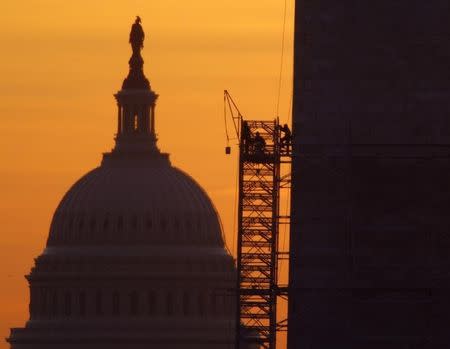U.S. economy resilient in Q3 as global growth cools

By Lucia Mutikani WASHINGTON (Reuters) - The U.S. economy grew at a much faster pace than initially thought in the third quarter, pointing to strengthening fundamentals that should help it weather slowing global demand. The Commerce Department on Tuesday raised its estimate of GDP growth to a 3.9 percent annual pace from the 3.5 percent rate reported last month, reflecting upward revisions to business and consumer spending, as well as to inventories. The rise in output followed a 4.6 percent advance in the prior three months to mark the two strongest back-to-back quarters since the second half of 2003. It underscored the economy's resilience against a backdrop of a Japanese recession, an anemic euro zone and a slowing China. "This report will go some way in providing further confirmation about the sustainability of the current economic recovery," said Millan Mulraine, deputy chief economist at TD Securities in New York. Economists had expected growth would be trimmed to a 3.3 percent pace. When measured from the income side, the economy grew at its fastest pace since the first quarter of 2012. But the otherwise upbeat picture was marred somewhat by other data showing consumer confidence sliding to a five-month low and a further moderation in house price gains. U.S. stocks were little changed while the dollar slipped against a basket of currencies. Prices for U.S. Treasury debt rose marginally. The ebb in consumer confidence in November was surprising given falling gasoline prices and a firming jobs market. "Economic growth is strong and getting stronger by the day. The consumer gets it, even if they aren't yet saying it," said Chris Rupkey, chief financial economist at MUFG Union Bank in New York. The third quarter was the fourth out of the past five that the economy has expanded above a 3.5 percent pace, well above the level economists consider to be trend. Some of the momentum appears to have carried over into the final three months of the year, with data from manufacturing to employment and retail sales suggesting continued strength. But with inventories rising more than previously estimated in the third quarter, economists expect the pace of restocking to slow, holding growth below a 3 percent pace in the fourth quarter. STRONG FUNDAMENTALS Highlighting the economy's strong fundamentals, growth in domestic demand was raised to a 3.2 percent pace from the previously reported 2.7 percent rate. "This is vindication for the Federal Reserve that they downplayed concerns overseas and it's appropriate to speak about rate hikes next year," said Christopher Low, chief economist at FTN Financial in New York. The U.S. central bank has kept benchmark borrowing costs near zero since December 2008, but is expected to start raising them around the middle of next year. Consumer spending, which accounts for more than two-thirds of U.S. economic activity, was revised up to a 2.2 percent pace in the third quarter from the previously reported 1.8 percent rate. Business spending on equipment was raised to a 10.7 percent rate from a 7.2 percent. While exports grew, the pace was less brisk than previously reported, leaving trade contributing only 0.78 percentage point to GDP growth instead of 1.32 percentage points. Growth in wages and salaries was revised lower for both the second and third quarters. Economists said that brought the GDP-based wages and salaries measures into line with earnings figures from the government's survey of nonfarm employers. "This should ease concerns that the Fed was falling behind the curve due to mismeasured wage inflation data," said Michael Feroli, an economist at JPMorgan in New York. (Reporting by Lucia Mutikani; Additional reporting by Richard Leong in New York; Editing by Paul Simao)

